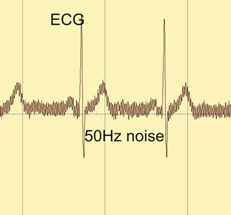A signal that that is almost always found in an electrophysiological measurement is coming from the mains, 220 V / 50 Hz in most European countries, 110 V / 60 Hz in many others. It is a common mistake to think that if you are not connected to mains (i.e.: use a battery powered amplifier) you are free of mains interference in your measurements. There are several ways how mains can interfere with your recordings.
Suppose that the body is completely floating and that the capacitive coupling to the mains and to the earth ground is equal. In that case the potential of the body will be 110 V with reference to the earth ground. This is the reason that TMSi amplifiers always use a floating measurement system, which means that the zero of the power supply of the measurement system is floating at the same 110 V. If there would be a (even moderate) difference between the zero of the power supply and the potential of the human body, the amplifier would go out-of-range and would thus not be able to amplify the signal anymore. For this reason, the zero of the power supply is connected to the human body (via the so-called Patient Ground input) so that under most circumstances the signals will be in range.
In that case, the potential of the body will only slightly differ from the zero potential of the power supply of the amplifier, both with reference to earth ground. This small difference is called the “Common Mode” signal, and is in the range of 0-100 mV, and the frequency will of course be 50 or 60 Hz. Common mode means that this signal is present on all the electrodes and is defined as the mean of all the electrode signals.
The mains interference part of the common mode potential is caused by the leakage current between the body and the zero of the amplifier, with the amplitude depending on the leakage current itself and the impedance of the electrode, that the leakage current is flowing through.
However, the mains interference is sometimes not a common mode signal at all. The cables between the electrode and the amplifier input are capacitively coupled to the mains as well. If the coupling is not exactly the same for all the cables, interference current will flow between the cables from one electrode to another, causing a differential mains interference distortion. This means that the mains interference will always be a combination of several distortions, and different solutions must be used to get rid of it. In the figure below, an example of 50 Hz noise is shown.

TMSi uses active shielding to minimize this mains interference. Each individual lead is shielded by the signal itself by means of a small coaxial cable. This solves two issues: the mains interference cannot reach the core of the lead, meaning that there is no capacitive coupling of the mains on the cable. The second issue that will be solved is the cable movement artifact. Read more about cable movement artefacts here.

